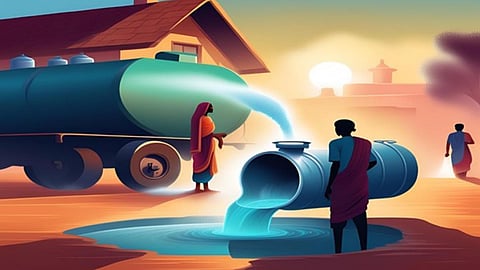
- Topics
- Feature
- Opportunities & Events
- Data
- Hindi Portal
- Topics
- Feature
- Opportunities & Events
- Data
- Hindi Portal

The recent water crisis in Delhi starkly underscores the looming water challenges faced by major Indian cities like Bangalore, Hyderabad, Chennai, and Mumbai. This situation reveals the anarchy prevalent in water resource management and governance. While the Delhi government and neighboring states engage in a blame game, water sector experts remain united. They emphasise the urgency of understanding groundwater's criticality, obtaining effective data on water usage, and promoting water reuse.
As this cycle of water mismanagement persists, the wisdom of management theorist Peter Drucker becomes relevant: “If you can’t measure it, you can’t improve it.” This quote highlights the necessity of metrics for effective management.
With the impending water crisis threatening major Indian cities and even semi-urban and rural areas, utilities still lack comprehensive water supply and consumer demand data. The difference in data availability between my first job as a data analyst and my role as a water policy researcher was like moving from Cherrapunji to Jaisalmer!
Advanced economies have embraced water consumption metering, but even India's largest water consumers are not tapped yet. The lack of data on water consumption can be attributed to two primary reasons: 1) India's socio-political landscape makes enforcing water metering and household-level charges challenging, and 2) the costs of instrumentation and metering often outweigh perceived benefits.
While exploring water conservation, I encountered an innovative start up that addresses these issues. Engineers from IIT Kanpur, recognising the same challenges, adopted an engineering approach to develop affordable, reliable, and accurate water meters. This led to the formation of Kritsnam, an innovative start-up incubated by IIT Kanpur's Startup Incubation and Innovation Center (SIIC).
Kritsnam, founded by K. Sri Harsha, a hydrology and water resource management graduate, took an engineering approach to solve the water conservation challenge. Harsha is driven by a commitment to water management and is focused on inventing accurate, affordable, and accessible water metering devices. Institutional support from SIIC facilitated the development and prototype testing of these devices. Collaborations with institutions like the World Bank and NGOs further advanced their product lineup.
Vinay Chataraju, co-founder of Kritsnam, highlights their unique position as trained hydrologists in water metering device development. Their scientific focus on water metering is reflected in product design and simple ingenuity in implementing it in the field. For example, they ensure laminar flow by installing meters in U-shaped pipe segments for accuracy.
Since its inception in 2015, Kritsnam has been improvising on its metering devices by developing cost-effective and accurate digital water flow meters. They have custom-made devices for large capacity borewells and small household water usage. Their latest product “Dhaara Smart Meters” are leveraging emerging IoT technologies on top of the temper proof and easy to install metering device. According to Vinay, they have installed more than 3000 meters, majority of them (~2500) are for the industrial users and the rest are for pilot scale implementation for agriculture and household usage.
While developing accurate devices addresses supply, creating demand for solutions is critical. Effective implementation faces challenges due to diverse stakeholder perspectives, overlapping jurisdictions, and varying governance models. Kritsnam’s critical demand threshold emerged from India's groundwater policy, which mandates industries to compensate for groundwater usage. This policy created a demand for Kritsnam’s products.
Vinay says, “Our majority of for profit activities are concentrated around the industries needing the water metering solutions because of the groundwater policy requirements.” He further added that “Innovation is in the DNA of our company, so we try to deliver the best solution, and not just meters to our clients”. Given the demand of their products is not just the metering devices, but access and reporting of the water usage, they focused on developing accurate, easy to install, temper-proof, and weather-proof smart water metering solutions amid growing IoT adoption. The product is recently launched as “Dhaara Smart”
Kritsnam's founders, motivated by a water conservation mission, work tirelessly to engage stakeholders, innovate financial models, and communicate the benefits of water metering. Their experience spans working with agriculture departments, municipal water bodies, industries, and individual households. The real challenge ahead lies in stakeholder convincing rather than engineering precision. The water meters still need either regulatory mandate or financial incentives to adopt at a wider scale.
Even after regulatory mandates, the cost recovery of the installed systems need to find innovative solutions. The encouraging thing about the mission-driven entrepreneurs, especially the “water-preneurs” is that they are devoted to the cause and tirelessly innovate not just devices, and engineering aspects but create incentives and financial innovations in challenging business environments to survive and scale.
Addressing "wicked" water problems requires combining science, policy, incentives, and political will. The current water crisis in Delhi should serve as an alarm for a new water management paradigm, shifting the focus from augmenting supply to managing demand. It is easy to shout about not having enough water. The water availability is going to decline over the years with increasing demand and India’s unique anthropogenic burdens. There is a need to develop and implement solutions that incentivise more efficient use of water and reduce wastefulness and leakages in the system.
Also read this story in our “Water-entrepreneurs” series that brings to light the tried and tested innovations made by people to find solutions to the water challenges they face in their local and often unique contexts.
Through our "Water-preneurs of India" series, we aim to spotlight the journeys of entrepreneurs addressing various water-related challenges. These innovators are developing scalable solutions tailored to India's unique needs, paving the way for a brighter, more sustainable future.